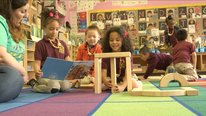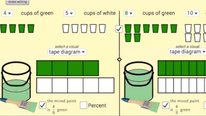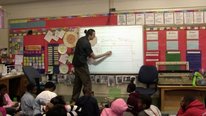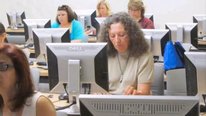
STEVEN MOORE
The Evaluation of a Model Spatial Thinking Curriculum for Building Computatio...
NSF Awards: 1543204
Spatial STEM+C is an exploratory integration project that is introducing K-5 students to spatial thinking as a way of improving computational thinking and mathematical performance. This video will provide a glimpse into the process of developing and pilot testing curricular activities for the project.
The Evaluation of a Model Spatial Thinking Curriculum for Building Computatio...
NSF Awards: 1543204
Spatial STEM+C is an exploratory integration project that is introducing K-5 students to spatial thinking as a way of improving computational thinking and mathematical performance. This video will provide a glimpse into the process of developing and pilot testing curricular activities for the project.
-
 Learning Trajectories for Everyday Computing (LTEC)
Learning Trajectories for Everyday Computing (LTEC)
Andy Isaacs
-
 Integrating STEM and Computer Sci into the Elementary Day
Integrating STEM and Computer Sci into the Elementary Day
Lisa Milenkovic
-
 Early Math is Big
Early Math is Big
Cody Meirick
-
 Visual Access to Mathematics: Supporting Teachers of ELs
Visual Access to Mathematics: Supporting Teachers of ELs
Johannah Nikula
-
 CAREER: Algebraic Knowledge for Teaching
CAREER: Algebraic Knowledge for Teaching
Meixia Ding
-
 Using a 3 I Professional Development System
Using a 3 I Professional Development System
Betsy Stefany
8521 Views
Continue the discussion of this presentation on the Multiplex. Go to Multiplex
8521 Views
Related videos you might be interested in...
-
 Learning Trajectories for Everyday Computing (LTEC)
Learning Trajectories for Everyday Computing (LTEC)
Andy Isaacs
-
 Integrating STEM and Computer Sci into the Elementary Day
Integrating STEM and Computer Sci into the Elementary Day
Lisa Milenkovic
-
 Early Math is Big
Early Math is Big
Cody Meirick
-
 Visual Access to Mathematics: Supporting Teachers of ELs
Visual Access to Mathematics: Supporting Teachers of ELs
Johannah Nikula
-
 CAREER: Algebraic Knowledge for Teaching
CAREER: Algebraic Knowledge for Teaching
Meixia Ding
-
 Using a 3 I Professional Development System
Using a 3 I Professional Development System
Betsy Stefany
Steven Moore
Director of Spatial Studies
Thank you for visiting the Spatial STEM+C video. Our exploratory project is in its formative phase. Thus, our video focuses on our collaboration rather than details about how we are linking spatial thinking, computational thinking, and mathematical performance. We are especially interested in discussion regarding the assessment of computational thinking in the K-5 grades. However, please comment on any aspect of our project.
Katie Rich
Curriculum Developer
Hi Steven,
I’m interested to hear more about your process of collaboration. I’m working on a project that is a partnership between a university research group, a university curriculum development group, and a set of teachers who have done a lot of thinking about CT. We’re always looking for ideas about how to best harness the ideas of all groups, so we’d love to hear how you’ve done that.
Did the teachers at the partner schools help to develop the activities? Did the university partners advise teachers on how to go about implementing the activities? What was the focus of your collaborative meetings?
Steven Moore
Director of Spatial Studies
Hello Katie,
Thank you for your questions! Our collaboration with the schools and teachers has been largely organic, with Project Director Gary Scott spending a lot of time with the teachers to build trust and establish a working relationship in which the teachers are involved in the project as colleagues. It is helpful that Dr. Scott is a retired K-12 educator from LAUSD who spent most of his career in challenging inner-city school settings. Collaboration has been enhanced by active participation of the principal at Inland Leaders Charter School, Jason Jimenez, who is a graduate of the educational justice Ed.D. program at Redlands and a strong proponent of using spatial tools in K-12 education. The Spatial STEM+C project is an outgrowth of conversations among Dr. Jimenez, Dr. Scott, and myself over the past three years. At Lugonia Elementary School, the assistant principal, Honey Libao, is a former math coach for Redlands Unified School District and is a current graduate student in the educational justice Ed.D. program. She has been instrumental in aiding the pilot testing at that site. The teachers are developing the activities in collaboration with the project directors and staff. Our meetings primarily focus on documenting strategies that work, ensuring fidelity of implementation, and assessing spatial thinking, computational thinking, and mathematical performance.
Steve
Katie Rich
Curriculum Developer
Thanks, Steve. I was struck by your comment that meetings focus on documenting strategies that work. Can you give examples of some of the strategies that have been most successful? Is there a way for others to access your documentation of these strategies?
Steven Moore
Director of Spatial Studies
We are in the process of wrapping up the pilot period (first 6 months of the project) and documenting the activities that have been created. I will meet with Dr. Scott and come up with a preliminary list of activities. Our project plan is to produce an e-book for best practices and also share them from our project website (which is in development). Steve
Irene Lee
Research Scientist
Thanks for sharing your video. In a prior project, GUTS y Girls, we used games to foster the development of spatial, logical, and strategic skills in middle school girls. We used of the shelf games such as Blokus3D and Blokus2D, Mastermind, Mole in the Hole, Set, and Labyrinth. Have you considered using similar player vs player games? Are you finding (or hoping to find) the development of spatial skills to be associated with particular CT skills?
Steven Moore
Director of Spatial Studies
Hello Irene,
Thank you for this great list of games! We have not been using these games in particular, but a few (e.g., Blokus3D and Labyrinth) would fit in with the activities we have been using. A player v. player strategy is integrated into some of the activities the teachers are using in their classrooms, including timed completion of spatial patterns and use of a collaborative game developed by Dr. Scott called Math-E-Motion. We are hoping to find connections among spatial thinking and computational thinking abilities and have a matrix of connections I’d be happy to share (unfortunately, our project website is a bit underdeveloped at this point-I plan to work on that this summer). One of our biggest challenges is assessing CT in the K-5 grades. We will be working on a pilot assessment this summer.
Steve
Emily Peterson
Would you mind sharing a bit more about what you mean by computational thinking? Is it a subset of mathematical thinking or something distinct?
Steven Moore
Director of Spatial Studies
Hello Emily,
A good definition of computational thinking is provided by Google at https://www.google.com/edu/resources/programs/e... Computational thinking is a problem solving process that includes a number of characteristics, such as logically ordering and analyzing data and creating solutions using a series of ordered steps (or algorithms), and dispositions, such as the ability to confidently deal with complexity and open-ended problems. CT is essential to the development of computer applications, but it can also be used to support problem solving across all disciplines, including math, science, and the humanities. We feel that CT can be a precursor to some forms of mathematical thinking, but also a subset of mathematical thinking. An interesting discussion of CT in elementary education is going on at MSP Net: http://hub.mspnet.org/index.cfm/29088.
Gretal Leibnitz
HI Steve! For our Showcase project (i.e., Engineering Inclusive Teaching: Faculty Professional Development project) we partnered with ENGAGE Engineering, another NSF-funded project, to develop a webinar on a Spatial Visualization: A Promising Spatial Visualization Intervention for Promoting Student Equity (www.WSKC.org/EIT)). Dr. Sheryl Sorby has developed a spatial visualization program that has been useful in a variety of educational contexts, and I was wondering if you were familiar with her work? In the webinar above, based on Dr. Sorby’s work, colleagues from UC Boulder developed a Montessori-based, spatial visualization program for college students that I think could be readily adapted to elementary students. I applaud your efforts to ensure that spatial visualization skills are taught early!
Steven Moore
Director of Spatial Studies
Thank you Gretal! We are very familiar with Dr. Sorby’s work and have integrated her ideas into our project. I haven’t yet viewed the webinar linked above, but will do so ASAP. I’m also sharing it with our project team.
Gretal Leibnitz
In the field of spatial visualization it is hard not to be familiar with Dr. Sorby’s work! :-) I would really love to hear what you and your team think about the 8 hour spatial visualization intervention showcased in the link I shared! Thanks!
Sue Mellon
Hi Steve,
I would really to learn more about your activities and curriculum. I work with students identified as gifted in Pennsylvania. Spatial activities are a focus. I am always looking to add new tasks/projects/activities. I saw that your project website is being developed. Do you know what the URL might be? Or is there a current site that you will link your project site to?
Steven Moore
Director of Spatial Studies
Hello Sue. Apologies for my delayed response! Our project URL is http://spatialstudies.redlands.edu/spatial-stemc/. It is a placeholder, currently. By the end of the summer, though, it should be populated with current news and materials generated by the project. Cheers. Steve
May Jadallah
This is a fascinating project! Approaching spatial thinking through computational mathematics is great. Our project approaches spatial thinking through the use of digital mapping technology. http://videohall.com/p/664 We start with set theory operations to help students understand the foundation of the digital mapping software.
Steven Moore
Director of Spatial Studies
Yes. I voted for your project! I spend a lot of my time introducing GIS to faculty and students. Helping students understand the computational foundation of digital mapping software is a great approach. Cheers. Steve
Sue Mellon
Thanks, Steve for the url. I will check back.
Further posting is closed as the showcase has ended.